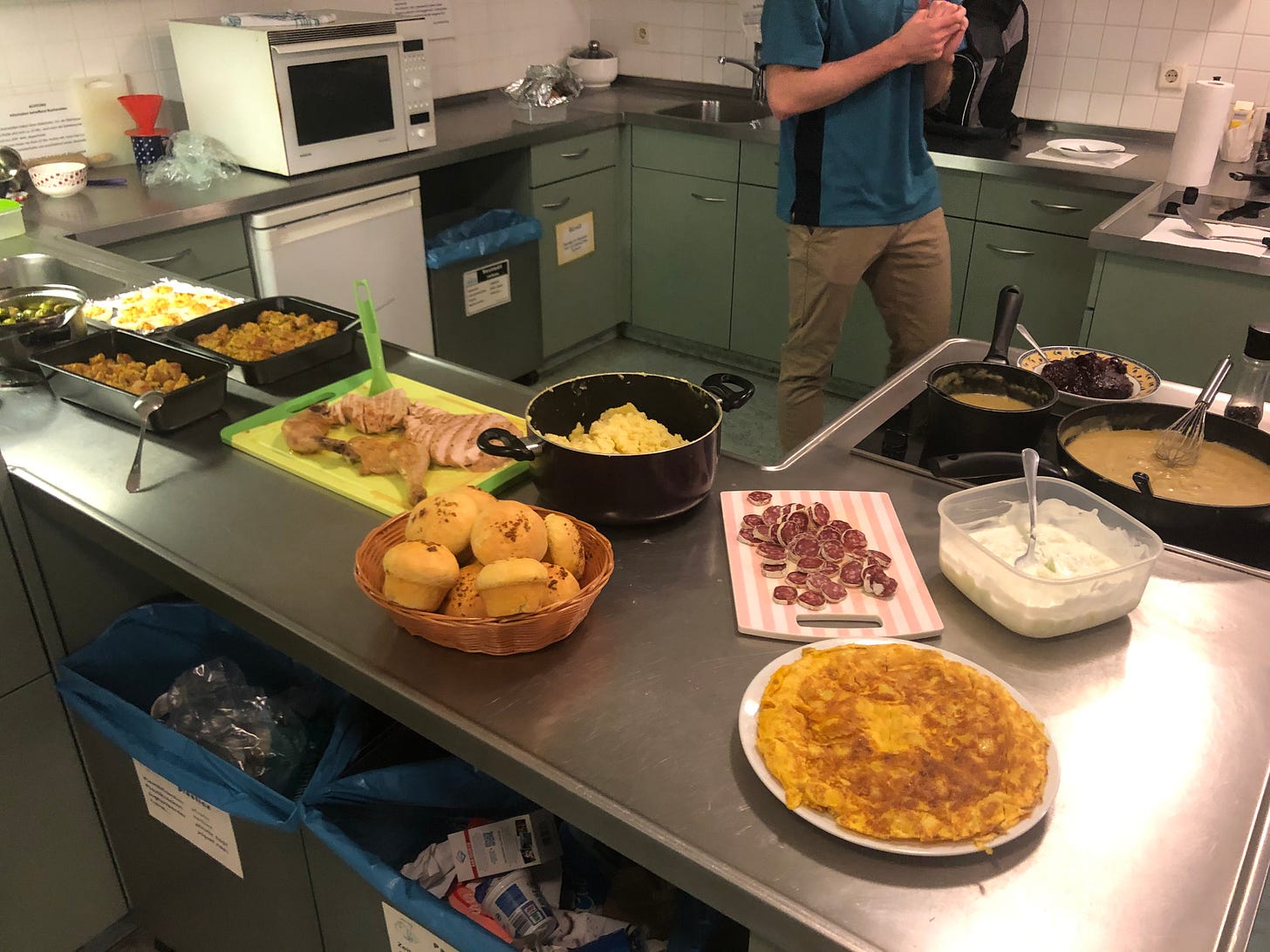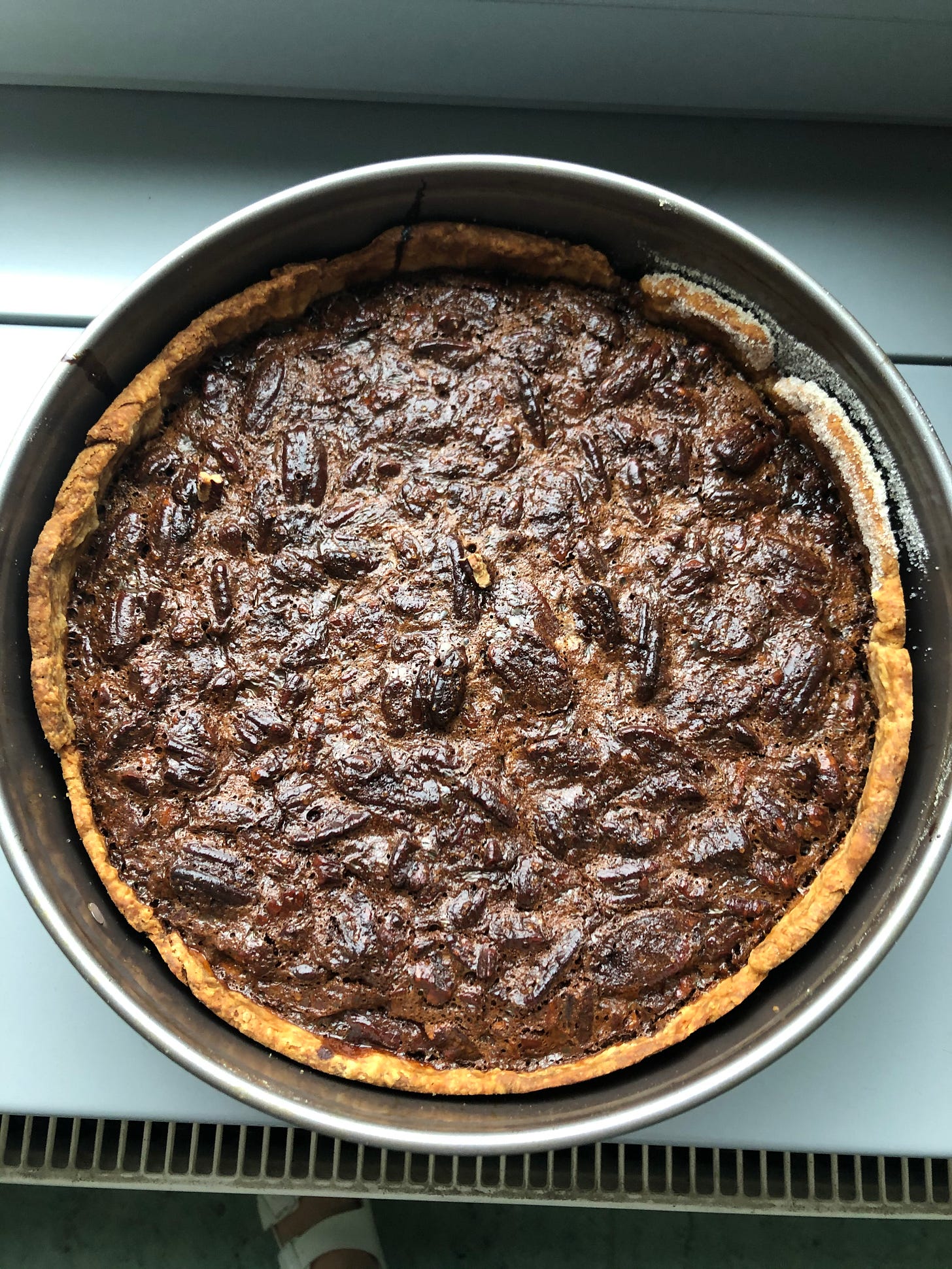“That looks like a total calorie bomb.”
This comment came from a student during a discussion about, what else, Thanksgiving. In particular, after I described and showed the students a picture of sweet potato casserole. It was quite perfect, actually: the teacher emailed me on Wednesday to say that the class had just started a unit on food, and to ask if I could talk on Friday about some typical American dishes or specialties? Of course! I replied. What better time to talk about American food than the day after the biggest food holiday of the year?
Indeed, food is something I’m very comfortable talking about (and it’s something I enjoy talking about immensely; see the unnecessarily long-winded “What I cooked“ section of this newsletter and newsletters past). Something I can’t so confidently address yet, on the other hand, is the history of the Thanksgiving holiday and the (post)apocalyptic experience of Indigenous Americans. I’ve been reading a lot this week (I’ll share links below) to gain ideas about how to talk about it with my students, which, of course, also involves a lot of re-learning things myself about that mythical feast of friendship between “Pilgrims and Indians” and everything that came in the 400 years since.
But maybe, as chef and member of the Oglala Lakota Sioux Tribe Sean Sherman wrote in an article for TIME last year, we don’t even need to tell a whitewashed history to find a reason to gather and spend a day cooking and baking and eating with family (virtually this year, of course*). “We do not need that illusion of past unity to actually unite people today,” he wrote. And the thing that unites people today? Food. “Most of our Thanksgiving recipes are made with indigenous foods: turkey, corn, beans, pumpkins, maple, wild rice and the like. We should embrace this.”
Next week I’ll teach at least two more lessons on Thanksgiving. I’ll be thinking a lot this weekend about how to balance the necessary but horrific truth about Thanksgiving’s history with the fact that, upon reflection, Thanksgiving is actually my favorite holiday (that is, after Passover). Maybe the way I’ll do this is with Sherman’s approach, highlighting why we eat the foods we do on Thanksgiving and where they come from, honoring just one of the past and present contributions of Native communities to the United States and suggesting that we should give thanks for that, too. (And maybe doing a bit of actual giving, too, if you’re able.)
In the spirit of giving thanks, I’m thankful for my friends and family who are reading this and otherwise checking up on me every once in a while. I miss you!
*on this note, here’s the reason behind this newsletter’s title, one of the funniest things I saw this week:
What I read this week (educational resources about Thanksgiving edition!)
In addition to the articles hyperlinked above, here are some things I’ve been reading, specifically related to the history of Thanksgiving, as promised:
“The Thanksgiving Myth Gets a Deeper Look This Year,” by Brett Anderson for the New York Times Food section
“Decolonizing Thanksgiving: A Toolkit for Combatting Racism in Schools,” by Lindsey Passenger Wieck on Medium
“Teaching Thanksgiving in a Socially Responsible Way,” by Amanda Morris for Teaching Tolerance, a project of the Southern Poverty Law Center
“The First Thanksgiving: Separating Myth from Fact,” by Ruth Hopkins for Teen Vogue (if you are rolling your eyes and scoffing at my inclusion of a Teen Vogue article in here, they have actually been doing really great reporting about politics and social issues, specifically for a younger audience, so I think this would actually be a great source for my students. Also, no one is above a horoscope reading every once in a while.)
What I cooked this week
The main event! I’ll try to keep this short (LOL at the fact that this was supposed to be a “quick update” in the first place). I started thinking about having a Thanksgiving dinner in my communal kitchen about a week ago, and starting planning in earnest…Saturday night. So you could say it consumed my week (but only because I wanted it to; I was wholly and completely willing).
I coordinated with two other Americans (both, like me, English TAs at other schools in the area, both, like me, feeling a little homesick during lockdown) to plan a true American Thanksgiving feast for Thursday night. I volunteered for the pies and stuffing (these are the things that I wanted control over because I think they could be easily messed up; I’ll entrust any schmuck with mashed potatoes and green beans) as well as cranberry sauce (in my maybe unpopular opinion, I find it to be one of the most important parts of the Thanksgiving spread) and also ended up responsible for the turkey and gravy. Fortunately, I had no classes on Wednesday afternoon and all day Thursday, so I was free to spend the whole day(s) baking and cooking and agonizing.
And it turned out really, really well. Each of us invited a few people from the dorm, making thirteen in total representing the U.S., Spain, Croatia, Austria, and Afghanistan. The girls from Spain brought a Spanish tortilla and a special salami, and one girl from Croatia brought a cucumber-yogurt salad, bringing our total vegetable count to two.

After everyone filled their (first) plates up, I insisted on going around the table and hearing what everyone was thankful for, and I couldn’t stop smiling. The meal itself was great, but it meant so much to me that all these people came and took part in the tradition.
If the main course was great, the dessert was—tooting my own horn a bit—outstanding. And it better have been, since I spent the better part of two days making the pies, from the crust to both fillings. I probably would have made a pie for Thanksgiving even if we didn’t have this big dinner, but as everyone knows, it’s better to share these things with others. (When did I start using so many clichés in my writing? Ugh.)
I made a sweet potato pie (recipe from the “pastry wizard” Stella Parks here) and a pecan pie (from who but Deb Perelman here), both using Parks’ crust recipe (which seems crazy but WORKS, here). I made sweet potato and not pumpkin because I heard people like sweet potato better than pumpkin, and I had to try it for myself. I don’t eat pumpkin pie often enough to issue a verdict on that front, but it was really, really good, and the next time we can gather enough people to warrant at least three pies I want to make both to have a proper taste off. I say at least three because the pecan pie was absolutely the show stopper, the best pecan pie I’ve had that I can remember. None of that, thick-layer-of-goo-with-a-thin-layer-of-pecans nonsense, no sir. She was dark, thick, and dense in the very best way. I don’t think I’ll look for a different pecan pie recipe ever again, and I’m someone who is so unsure about these things that she NEVER orders the same thing twice at a restaurant, even if the thing I had last time was really really good. I also say at least three because I almost bought another bag of cranberries (at 5 EUR a pop here!) to make this pie, because I love nothing if not a thick nutty crumble topping.
For everything else, I basically watched this video ten times, not because I care about astronaut food, but because I wanted to copy Sohla’s recipes and just her general demeanor. I mean, she cooked an entire Thanksgiving feast and wasn’t stressed AT ALL. I am stressed by the length of this newsletter.
On that note, bis bald!
Emily






